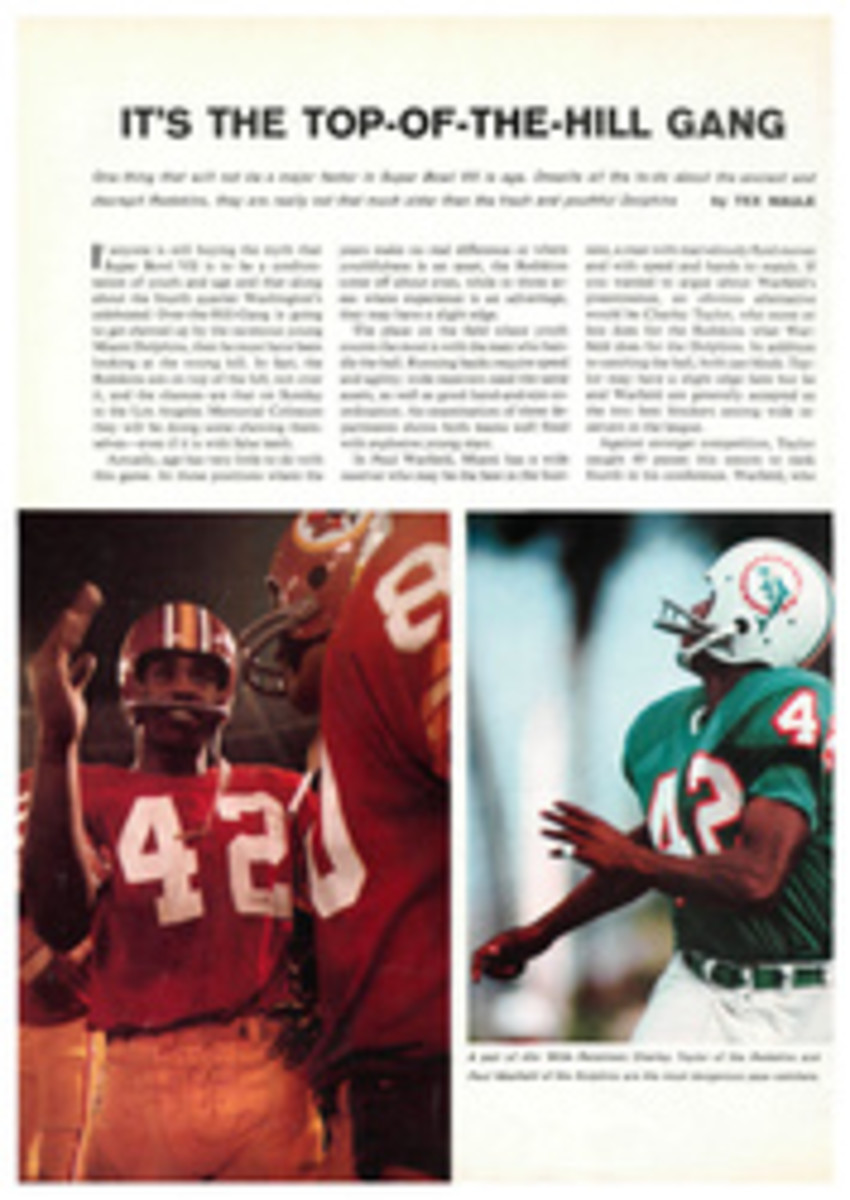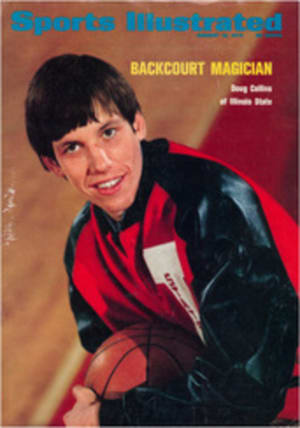
IT'S THE TOP-OF-THE-HILL GANG
If anyone is still buying the myth that Super Bowl VII is to be a confrontation of youth and age and that along about the fourth quarter Washington's celebrated Over-the-Hill-Gang is going to get chewed up by the ravenous young Miami Dolphins, then he must have been looking at the wrong hill. In fact, the Redskins are on top of the hill, not over it, and the chances are that on Sunday in the Los Angeles Memorial Coliseum they will be doing some chewing themselves—even if it is with false teeth.
Actually, age has very little to do with this game. At those positions where the years make no real difference or where youthfulness is an asset, the Redskins come off about even, while in those areas where experience is an advantage, they may have a slight edge.
The place on the field where youth counts the most is with the men who handle the ball. Running backs require speed and agility; wide receivers need the same assets, as well as good hand-and-eye coordination. An examination of these departments shows both teams well fixed with explosive young stars.
In Paul Warfield, Miami has a wide receiver who may be the best in the business, a man with marvelously fluid moves and with speed and hands to match. If you wanted to argue about Warfield's preeminence, an obvious alternative would be Charley Taylor, who more or less does for the Redskins what Warfield does for the Dolphins. In addition to catching the ball, both can block. Taylor may have a slight edge here but he and Warfield are generally accepted as the two best blockers among wide receivers in the league.
Against stronger competition, Taylor caught 49 passes this season to rank fourth in his conference. Warfield, who was hurt for several games, caught only 29 but for longer average yardage (20.9 per catch against Taylor's 13.7). Earl Morrall, the Miami quarterback for most of the season, regularly went to War-field in desperate situations. By contrast, under similar circumstances, Billy Kilmer, the Redskin quarterback for most of the year, was just as inclined to look for Roy Jefferson as for Taylor. Jefferson caught 35 passes during the season and also is a fine blocker, giving the Redskins such strength at that position that Clifton McNeil, who led the league in pass receiving only four years ago, hardly played all season.
The Dolphins also have a former conference leader, Marlin Briscoe, sitting on the bench. He and second-year man Otto Stowe play behind Warfield and Howard Twilley, who has exceptional hands and who catches the short pass well but lacks the speed to be a deep threat. Twilley and Jefferson are both 29, Warfield is 30 and Taylor is the gray-beard of the group at 31.
At tight end the Dolphins start Marv Fleming, 31, who catches the ball better than most scouting reports suggest and is especially adept at hanging on to the tough pass over the middle on difficult third-down plays. Jerry Smith of the Redskins, 29, is an outstanding receiver among tight ends, with the ability to break open for a long gain. Mack Alston, a determined blocker, is only 25 and now alternates with Smith.
But if both teams' receivers are right on top of the hill, the age differential among running backs is equally negligible. Along with Larry Csonka, probably the best tough short-yardage gainer in the league, the Dolphins have Mercury Morris, always a long threat, and Jim Kiick, a slashing runner who gets better the closer he comes to the goal line. But though they comprise the best set of three backs in the NFL, Larry Brown, the 5'11", 200-pound Redskin wonder, is definitely the best one.
Oh, yes, age. All four of the above are in their mid-20s. Charley Harraway, slightly older at 28, is the other Redskin starter, but he confines most of his endeavors to clearing linebackers from Brown's path. The Redskins also have a baby back, Herb Mul-Key, who is 23 and perhaps faster than Morris.
Since both teams have good offensive lines in their primes, it becomes apparent that the age controversy really involves only the defenses, and it is here that most of George Allen's elderly Redskin troops are found. Elderly—but hardly decrepit. And it is along the defensive line, particularly, where experience often means more than peak physique. Since he came to Washington last season Ron McDole, the 33-year-old left end, has played as well as he ever has. His cohorts range down from Verlon Biggs (29) and Diron Talbert (28) to Bill Brundige (24). In comparison, the Miami front four is much younger—Manny Fernandez being the old man at 26—but it is the Redskins' venerable vandals who should now be at the height of their abilities as pro linemen.
Miami has young, good outside linebackers in Doug Swift and Mike Kolen, both 24, but the heart of its defense is 32-year-old Nick Buoniconti in the middle. Curiously, Washington has a young middle linebacker in Harold McLinton, 25, alternating with an old middle linebacker, Myron Pottios, 33—with additional experience on the corners in Jack Pardee, 36, and Chris Hanburger, 31.
The Redskin secondary is considerably older than that of the Dolphins, with Rosey Taylor at free safety the oldest of the lot at 34. The senior citizen of the Dolphin defensive backfield, Jake Scott, is 27, the same age as Mike Bass, who is the youngster of the Redskin secondary.
The old boys notwithstanding, Washington's secondary can boast much the same statistics as Miami's. The Redskins' tight zone permitted 133 yards per game passing, while the Dolphins gave up 124.9. Against the Redskins 50.7% of passes were completed; against the Dolphins 51.1%. And unquestionably the Redskins had better people passing (and running and blocking and tackling) against them.
Miami's regular-season opponents won a total of 70 games; Redskin opponents won 86. Only two teams on the Miami schedule were over .500, and they barely scraped by at 8-6. Washington played five games against winning clubs, and two of them were 10-4.
Moreover, while Coach Don Shula's Dolphins are undefeated, it was the Redskins who appeared to grow stronger as the season progressed. True, they lost their last two regular-season games, but that was after the team had won its division and Coach George Allen was resting Larry Brown. The two best games Washington played all year were the playoff routs of Green Bay and Dallas.
The Dolphins have been struggling. It took a late touchdown for them to beat wild-card Cleveland 20-14, and they squeezed by Pittsburgh 21-17 even though the Steelers' starting quarterback, Terry Bradshaw, missed more than two quarters of action.
In that game the Dolphins lost starting Left Cornerback Tim Foley, which could be costly when you consider how deftly Kilmer attacked the weak spot in the Dallas defense—left cornerback. Probably no quarterback is more adept at going for the jugular than Kilmer, and he can be expected to probe the Dolphin left side early and often. Called Furnace Face because his normally florid complexion begins to glow as game time nears, Kilmer has been red-hot lately. In the two playoff games he completed 21 of 32 passes for three touchdowns and no interceptions.
Bob Griese, 27, will start for Miami instead of 38-year-old Earl Morrall. Griese was All-Pro last year, but was injured and missed most of the regular season; in the playoffs he worked only a couple of quarters against Pittsburgh. The Redskin players thought it was too much to expect the Cowboys' Roger Staubach to come back as a starter against them in the conference championship—and they turned out to be right. Certainly, as talented as Griese is, he cannot be expected to be in top form.
Griese does have more of an arsenal to turn to if his passing is off, however. For example, if the Redskins stop Csonka and Kiick inside they may get whipped by Morris on the sweeps. If Miami manages to stop Brown, then a much greater burden falls upon Kilmer's passing.
In summary, the clear advantage seems to lie with the Redskins. Miami has a slight edge in rushing, but it is offset by a Redskin defense that shut off the strong running games of Dallas and Green Bay. Washington has experience and a quarterback on a tear. Call the coaching even.
Finally, Washington scored most often during the regular season in the second and fourth quarters, when old men are supposed to be dragging. It was the young Dolphins who scored their least in the final quarter. So, who is over the hill anyway? Washington should win Super Bowl VII by at least 10 points and perhaps by as many as 21.
TWO PHOTOS
A pair of 42s: Wide Receivers Charley Taylor of the Redskins and Paul Warfield of the Dolphins are the most dangerous pass catchers.

